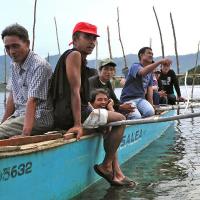Marine Life Encyclopedia
Seabirds
King Penguin
Aptenodytes patagonicus
Distribution
Subpolar latitudes in the southern hemisphere
ECOSYSTEM/HABITAT
Nest on beaches and rocky shores; feed in sub-Antarctic currents
FEEDING HABITS
Foraging predator
TAXONOMY
Order Sphenisciformes (penguins), Family Spheniscidae (penguins)
Emperor penguins spend all year in Antarctica, while king penguins live in sub-antarctic island groups and in southern South America. The king penguin is the largest penguin outside of Antarctica.
King penguins are foraging predators that feed primarily on fishes (but occasionally take squids) in shallow water near their nesting sites. Many predatory seabirds are known to take juvenile king penguins, while leopard seals, killer whales, and other large predators are the only species that typically eat adults.
Though they feed in the marine environment, king penguins mate and nest on rocky shores during the southern hemisphere summer, when both male and female remain faithful to their partner for at least one nesting season. Approximately one third of all individuals remain faithful to the same partner for multiple years. Each parent participates in incubating a single egg, by taking turns resting the egg on its feet while the other parent feeds. After hatching, the parents continue to care for the juvenile for approximately one year. During this time, the juvenile is dependent on its parents for food, warmth, and protection from predators.
With apparently increasing populations, the king penguin has been determined to be a species that is not at risk of extinction. It is not dependent on ice for nesting (like Antarctic penguins) and it generally does not live in places with significant local human impacts (like South American or African penguins). And it does not rely on krill and other prey that are vulnerable to overfishing and climate change (like many other Southern Ocean predators). However, it is important to continue to study king penguins and monitor their populations to ensure that any future negative trends are discovered early and are handled accordingly.
Engage Youth with Sailors for the Sea
Oceana joined forces with Sailors for the Sea, an ocean conservation organization dedicated to educating and engaging the world’s boating community. Sailors for the Sea developed the KELP (Kids Environmental Lesson Plans) program to create the next generation of ocean stewards. Click here or below to download hands-on marine science activities for kids.
Additional Resources:
Get Involved
Donate Today
SUPPORT OUR WORK TO PROTECT THE OCEANS BY GIVING TODAY
With the support of more than 1 million activists like you, we have already protected nearly 4 million square miles of ocean.
TAKE ACTION NOW
Support policy change for the oceans
Decision-makers need to hear from ocean lovers like you. Make your voice heard!
VISIT OUR ADOPTION CENTER
SYMBOLICALLY ADOPT AN ANIMAL TODAY
Visit our online store to see all the ocean animals you can symbolically adopt, either for yourself or as a gift for someone else.
DOWNLOAD OCEAN ACTIVITIES
HELP KIDS DISCOVER OUR BLUE PLANET
Our free KELP (Kids Environmental Lesson Plans) empower children to learn about and protect our oceans!




